Introduction
New for the 2023 - 24 season, the Atomic Hawx Ultra XTD 130 BOA GW is an updated, revised version of Atomic's already successful entry into the one-boot does it all category. Let's just call this mouthful the Hawx 130 v2 (with 130 referring to its flex index; ie it's stiff). This boot replaces the Hawx 130 v1 (original review here from Newschoolers) which was relatively light yet reasonably stiff (1415g - sz 26). Hawx v1 was subsequently adopted by many as a resort/touring 50/50 boot. The Hawx 130 v2 shares one thing with the v1 iteration. It's got a lot of room for boot fitters to work with, starting with a medium-narrow last (but not as low volume or narrow at Hawx v1), a thermo-moldable shell (Atomic's MemoryFit and the more moldable Polyurethane plastic material) and a thermo-moldable boot liner.
The Hawx v2 is quite a bit heavier/still stiff (1819g - sz 26 - ACTUAL measured weight). Suppose you're an aggressive skier. Perhaps you're bigger. You want tech fittings to cover off all bases. You might travel for skiing and you don't want to haul a bunch of boots around. You tour a bit but most of your time is spent on the resort. In a nutshell, if you're OK with sacrificing some touring ability for resort downhill performance then you should consider the Atomic Hawx 130 v2.
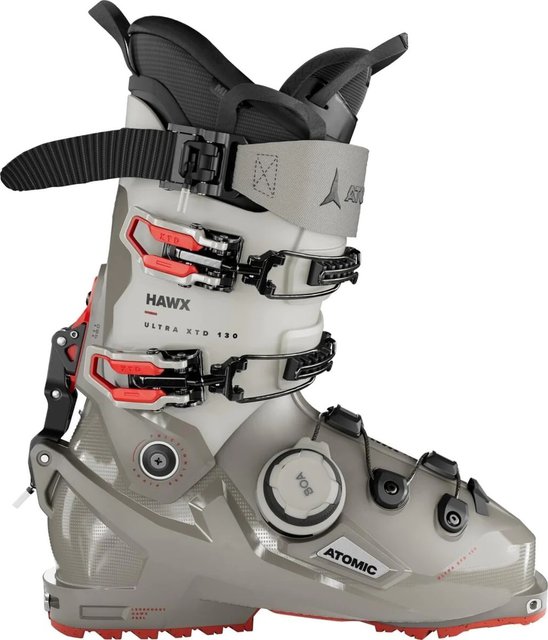
Hawx Ultra XTD 130 BOA v2
Reviewed here is the highest end version with the BOA boot closure system. To very briefly touch on the differences in this new version; the new boot gets polyurethane (PU) plastic, a new Mimic liner, new "Trueflex" construction (a manufacturing technique to promote flex and constant feel even when temperatures change). Repeating the often-said mantra that all touring equipment is about compromises (uphill vs downhill performance) Atomic's market/customer research showed that many were using the Hawx primarily as a resort boot with very occassional forays into short backcountry tours. Accordingly Hawx v2's design and compromises are tilted towards downhill performance.
MSRP will be $1,049 Cad. Sizes will be from 24.5 to 30.5. If you have a smaller foot then the only available option are the Hawx Ultra XTD 115 W which goes down to 22.5 in size but is priced a tad more affordably at a MSRP of CAD $849.
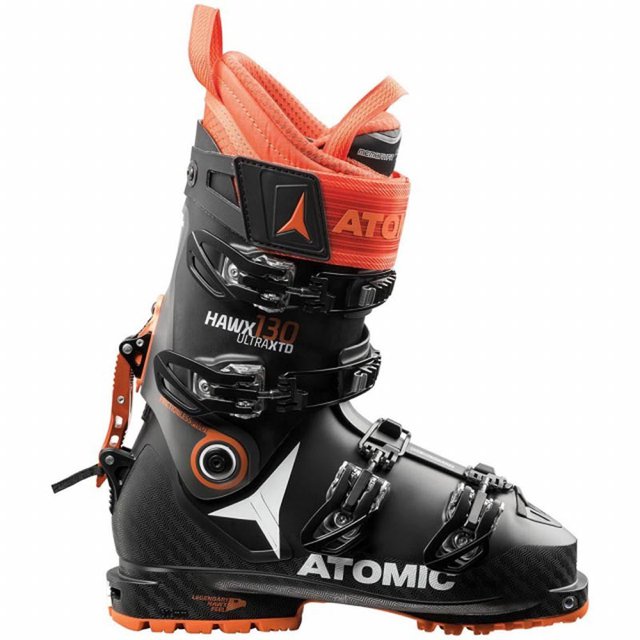
Hawx Ultra XTD 130 v1 (mine are still going strong after 100+ days of skiing)
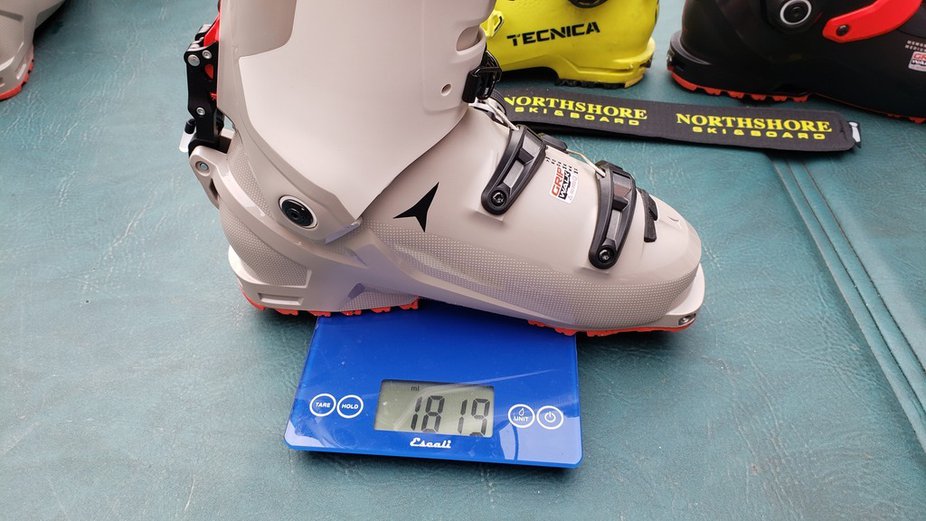
Actual weight of Hawx v2 in size 26.5. Weighed without optional volumizer or laces. Spoilers are also available for those wanting extra forward lean. The Atomic Hawx BOA v2 shell weighs 1400g (v1 shell weighs 1135g in the same sz 26.5).
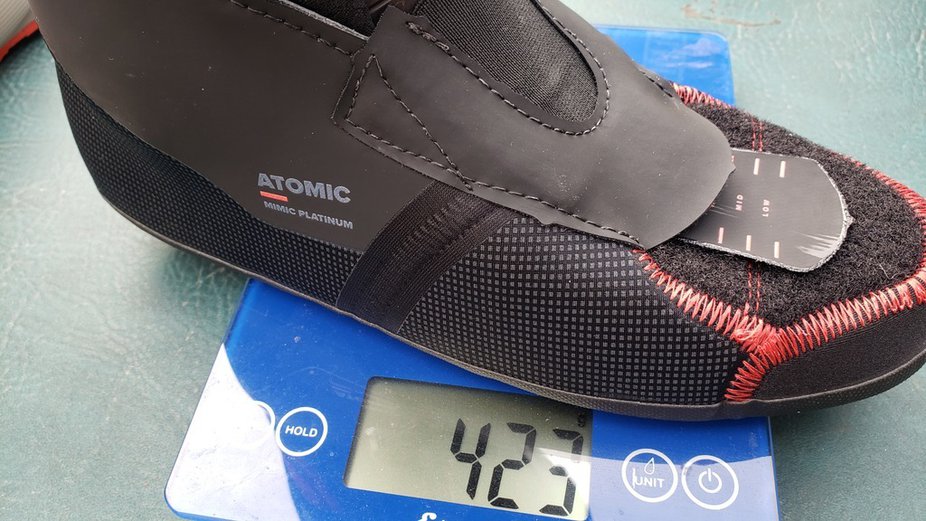
The newer Atomic Mimic liners are hefty coming in at 423g weighed with the stock footbed. That's heavier even then the v1 Atomic Hawx liner + footbed at 292g. For extra data, an Intuition ProTour liner weighs 268g
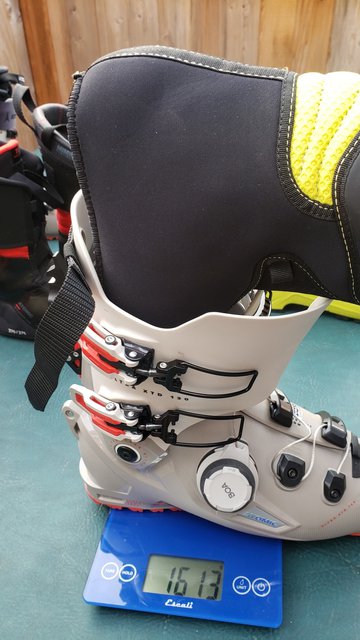
If you really want to weight-weenie, you can get the Hawx v2 down to 1613g using the ethereal (but fragile; good for about 30 days) Tecnica liner). Lose the Atomic bootboard and power strap and eke out another 50 or so grams of weight. But then maybe you've got the wrong boot.....
About the reviewer
At just 160 pounds I'm not a big guy but do spend 90+ days a season skiing, with many of those days in backcountry. I had 4 days on the Atomic Hawx Ultra XTD 130 BOA GW in size 26.5 (bsl 302mm identical to v1 bsl) all resort-based skiing. Due to the extreme lack of samples and my lack of time on the boot, I only toured a half day on the boot..
I currently ski on the Tecnica Zero G Tour Pro, a Atomic Hawx XTD v1, a Scarpa F1 and the new Atomic Backland XTD 120 (which I am loving and have an upcoming review) but have had experience with a wide variety of boots. If you have questions about one boot versus the other please ask away.
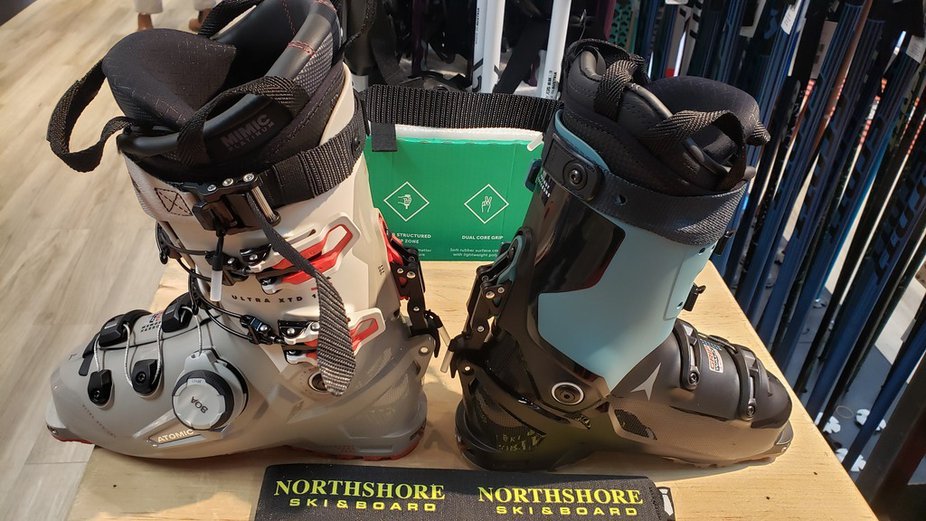
Hawx v2 mens vs Hawx v2 womens. Note both the top-end Hawx mens and womens boots use a 50mm-wide power strap with a cam. The strap itself is a very thin but sturdy-feeling fabric. The lower-end Hawx v2 boots will use a velcro strap.
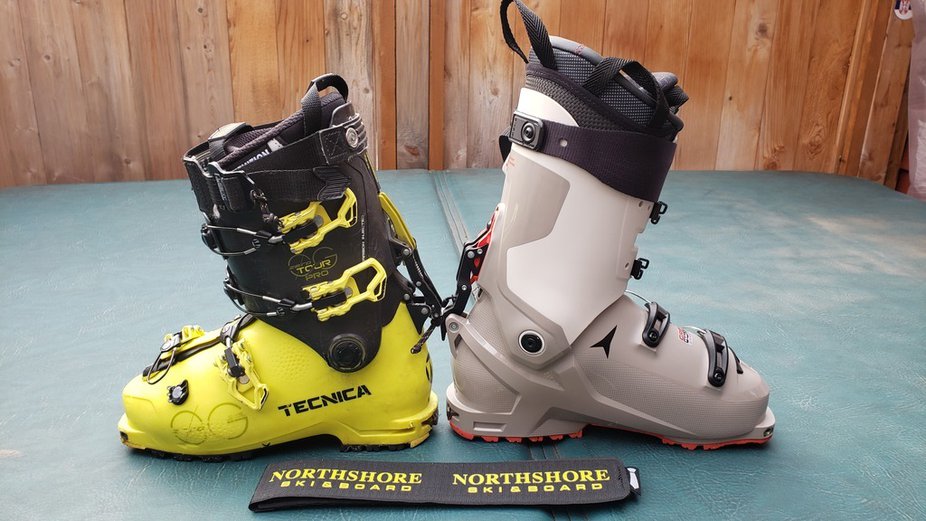
Tecnica ZeroG Tour Pro 130 (my personal dedicated touring boot) vs Hawx v2. The Hawx shell and liner are noticeably taller. The Tecnica ZGTP weighs 1326g; the Hawx weighs 1819g
Quick Stats
Here is a brain dump on the Hawx v2 cribbed from Matt Manser (the boot designer of both the Hawx vers 1 and vers 2) via a thread on the TGR forums discussing the boot
• Same last as before (no changes)- 98mm/26.5
• Same out-of-the-box geometry as before- 15° forward lean, 4° ramp angle.
• Same 54° of cuff ROM.
• Full PU construction, cuff & shell. No Grilamid, no Pebax, no polypropylene, no polyolefin.
• Thicker lower shell and thicker cuff for more stability, better damping, more durability for daily resort use.
• All new Mimic liner construction with our 3D stretch toe box, an adjustable/removable tongue and a much improved Achilles Flex Zone to match the cuff movement.
• New ski/walk mechanism allows for 3 forward lean settings (no flip chips) 13°-15°-17°
• New glued-on Skywalk GripWalk rubber sole ISO 23223 (lower standheight & less weight allow us to go full PU but still keep a respectable weight).
• Available with an all new, ski boot specific BOA system or traditional buckles (assuming this will be a bigger discussion to follow)
• Unisex flexes: 130, 120, 110
• Women’s flexes: 115, 95
• 1830g / 26.5
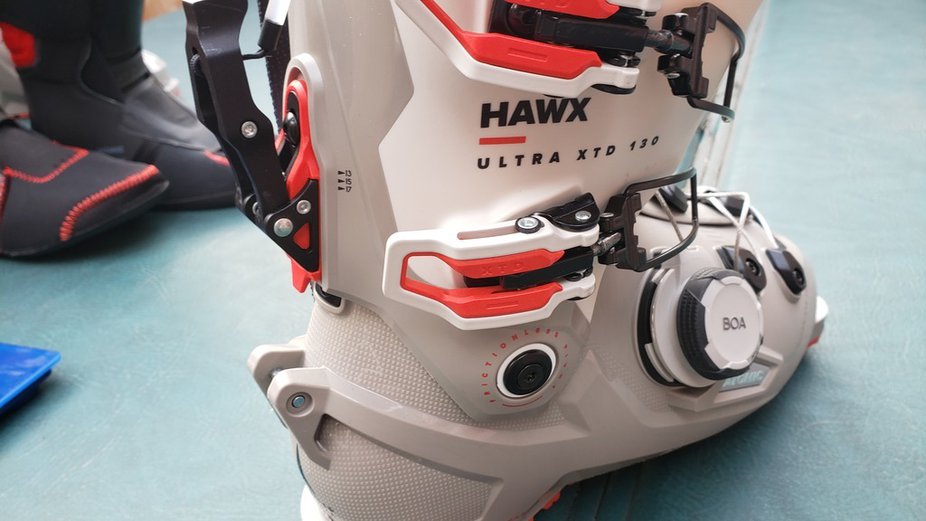
Buckles are conventional microadjustable with nice long gates to accommodate different sized ankles. The ladders on the buckles are spring-loaded so the buckles are retained when loosened for touring. They're assembled with lots of loctite (good!).
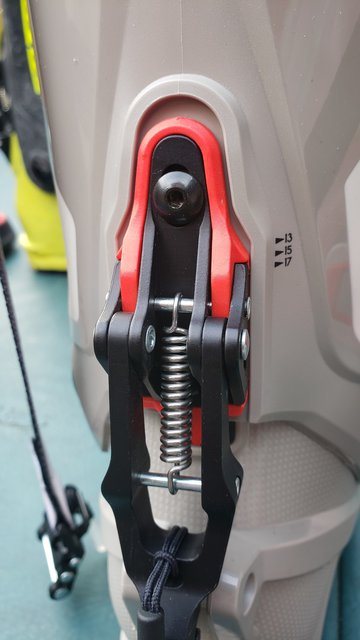
Closeup of the Atomic "Powershift" forward lean mechanism which remains unchanged except for slightly tweaks. Hawx v2 comes stock at 15 deg forward lean. Simply loosen the allen bolt to slide the hardware up or down to get to either 13 or 17 deg. Remember to reassemble with lots of loctite. The walk mode is familiar, easy to operate and quite beefy.
Also pictured is the external construction of the "Energy backbone - a reinforced, asymmetric backbone "providing extra strength for powerful skiing plus enhanced lateral energy transmission for better edge grip"
Fit
I have a generic Azn foot - wide and flat. I have almost no arch, a big "sixth toe" tumour on the metatarsal, a splayed out forefoot meaning I need to somehow get 110mm of forefoot into a 98mm last (26.5 size) and an average sized ankle and instep. As another fitting data-point I am a size 26 in Tecnica, Atomic and Salomon. My bottom line is that, if you fit a Hawx v1, you will likely fit the Hawx v2 but read on.....
Despite the rather alarmingly large delta between my wide-as-a-truck feet and 98mm last I was able to get a tight, performance fit on the Hawx v2 **without** even MemoryFit or forefoot boot punch. This frankly confused me. There is/was no way I could get my feet into an unmolded, unfitted Hawx v1. Yet I could squeeze into the Hawx v2 (albeit with forefoot tightness) even though both boots are 98mm lasts. It was explained to me by Matt Manser (Atomic's boot designer) that the boot last width is identical so if you have a low-volume foot and want performance then v2 is still an option. The difference I feel is in the plastic. Grilamid (used in v1) is more rigid & less forgiving. Polyurethane (v2) is more malleable and has a "softer" feel. Therefore v2 in the same size as v1 will feel wider because the plastic is softer but the boot (v2) is also stiffer due in large part to construction techniques and the fact that there is more material. The fit will be almost exactly the same.
Moving on to other similiarities, the Hawx v2 generally has a narrow'ish heel pocket and a fairly low instep height. These attributes are for performance and designed to keep the heel in the heel pocket. V2 also retains Atomic's Memory Fit allowing the boot shell and liner to be cooked in a special oven and then allowing foot pressure to then expand/mold both shell and liner to one's foot. I've already experienced the miracle of Memory Fit allowing expansion of 5mm in the boot shell and approx 5mm in the liner for my v1 boots so can attest that it works very well.
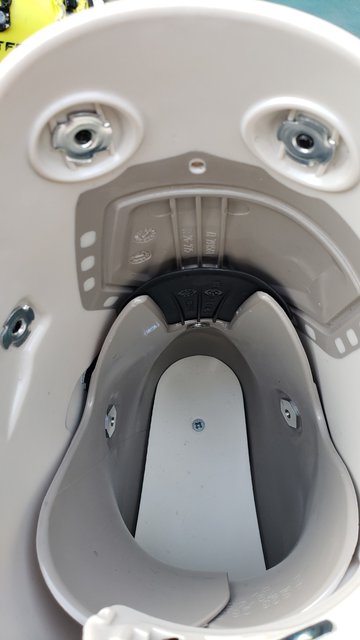
Inside of the boot shows a classic overlap design with a rear cuff pushing against a reinforced spine. See also hardware attaching power strap; scallops and a removeable boot board
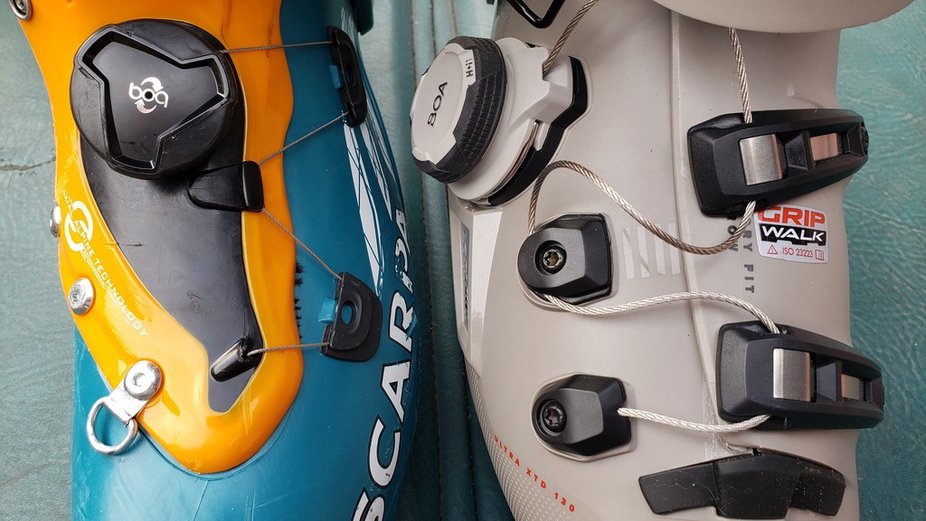
The BOA system is not that common in touring boots but moreso on snowboard boots. Atomic didn't mess around and spec'ed thick cables. Compare the Hawx v2 Boa to my Scarpa F1's BOA cables (used 200+ days without issues)
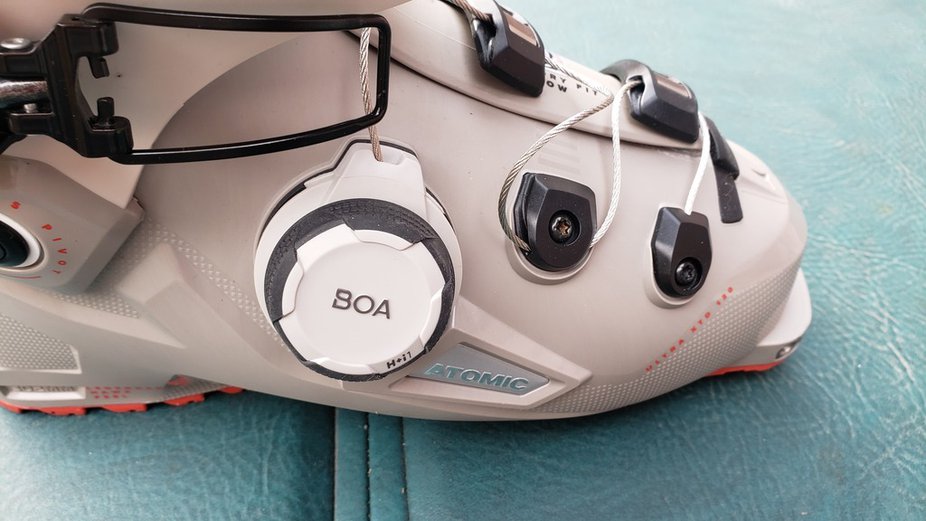
Per Atomic - the BOA allows you to "Dial up or down to create your perfect fit – with a smooth, uniform closure, so you can put less energy into keeping your foot secure and more into keeping control. Push in to engage, turn to tighten or loosen and pull up the dial for a quick release." There's no doubt the looks of the Boa may be polarizing. The location also leads to potential concerns; will they be too exposed when on sleds, in gondolas, while bootpacking?
Construction
The obvious big construction difference between v1 and v2 boots is; (i) the lower forefoot BOA system, replacing two lower buckles; and (ii) PU as opposed to the Hawx v2 PA (polyamid/grilamid) plastic.
The BOA system is a metal cord routed through different pulleys on the boot lowers actuated by a large dial near the outside of the midfoot. This cord is routed around 3 different pulleys, the effect of which is uniformly wrap your foot in the lower shell as opposed to the point pressure of a buckle system and hopefully, to provide a more precise fit.
When the BOA wasn't locked down, the boot was touring-comfortable, as expected. Ie it was loose enough for walks to the lifts. When the Hawx v2's BOA is engaged, I found that I didn't have to clamp my foot as tightly as I did when using the buckles with Hawx v1. To explain further, the BOA locked my foot in tightly and securely even despite my perception that I didn't cinch down Hawx v2 (via BOA) as much as I cinched down Hawx v1 (via buckles). Others have pointed out that they didn't have the same experience of that so-sweet BOA uniform lock-down. To that all I can say to that, is that Hawx v2 fit my feet quite well even without punching, stretching, thermo-fitting so I speculate that, when paired with a boot that already fits you well; BOA is going to lock your foot down evenly, securely and with sweetly consistent foot pressure. Pair BOA with a boot that doesn't fit well and you may well have as not as good an experience. In other words, start with a boot that fits well or get your boot fitted properly to enjoy all the benefits of any boot closure; whether boot or buckles.
One (valid) criticism of Hawx v1 was the difficulty in opening the lower so that anyone with ankle mobility issues probably did not enjoy the experience of getting into that boot. This was not an issue with v2 where you undo the top buckles, loosen the BOA and you get in as easily as you do with any other touring overlap boot. Since the throat open/closure of the uppers of Hawx v2 and v1 look to be almost the same, I'd have to attribute that to the softer and easier to open PU plastic of v2 vs the more rigid plastic of v1.
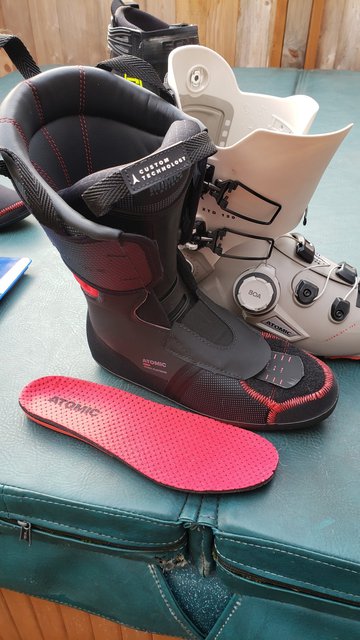
Stock footbed and Mimic Platinum liner which is OE with the Hawx Ultra XTD Boa. . Note the red material at the bellowed "Achilles" flex zone designed to promote fore-aft movement.
Customization
I didn't have to punch or stretch or the Hawx v2. I also didn't thermo-mold either the boot shell or the liner. I have spoken to boot fitters who've worked with the boot. There aren't many out there in the wild yet so the sample size is small and from the Vancouver area. With the caveat that this is anecdotal here is a brain-dump.
Re the liner. "Mimic" is actually a heat moldable plastic layer inside the liner. It creates the anatomic ankle & heel shape but is remoldable and hardens in whatever shape you give it. Mimic material is designed to allow heatmolding for fit, heel hold and overall performance + comfort. There is a new Mimic Professional liner (not pictured) which can be bought aftermarket through dealers and are updated with new microfiber outer materials & new internal constructions to offer a tighter fit and a longer lasting fit. Mimic Professional has new microfiber outers (basically a synthetic leather) are thicker & more supple, to better follow the contours of the foot and shell wall. The internal layup is also changed to be more anatomical so as to offer more hold from mid-foot to heel. The Mimic liner is (obviously) heavier than the industry-benchmark Intuition liner. I have no data on whether it's as stiff, as moldable, as warm or as long-lasting as the Intuition Pro-Tongue liner. As the season wears on it'll be interesting to gather data and anecdotes on that.
Re the boot shell. The main callout for boot-fitters will be that Hawx v2's shell is "classic" polyurethane plastic (PU) used in downhill boots as opposed to the carbon-infused Grilamid plastic used for lightness and relative temperature invariability used in boots more biased towards touring performance (eg the Hawx v1). Apparently the BOA dial can be removed and with that out of the way the boot shell can be molded and worked on.
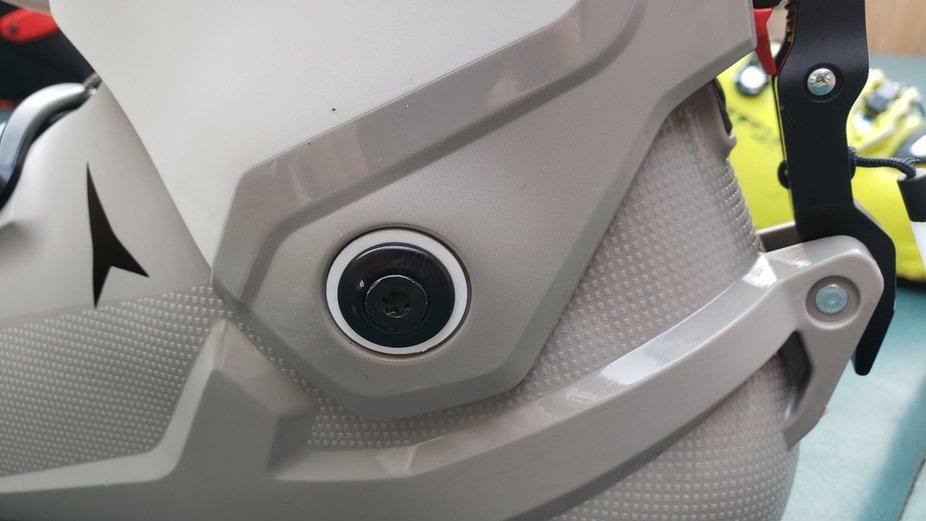
Also unchanged are those marvelous low friction IGUS polymer "friction-free" bushings; probably a reflection of the designer's biking background. If the pivot does get play (my V1 Hawx boots are just getting play after 150+ days) tighten them up using a torx bit and a thin walled socket on the inside of the boot
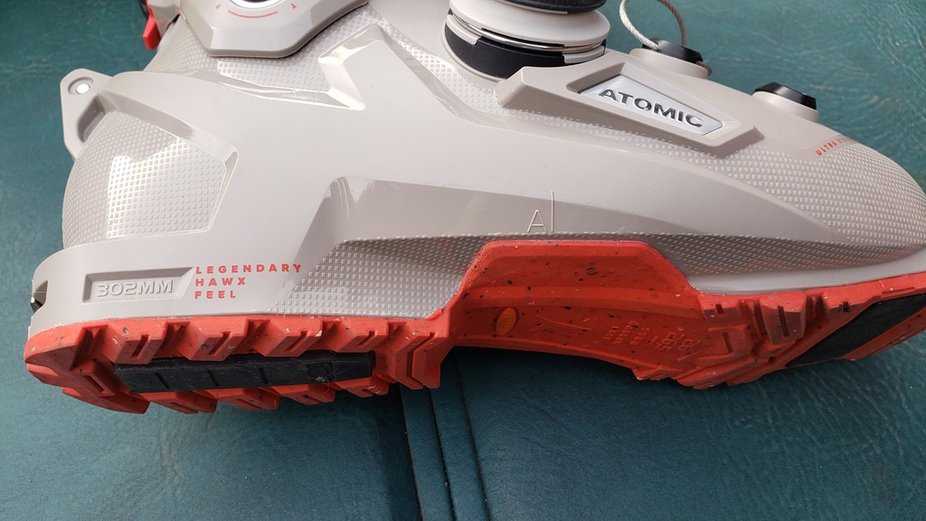
Gripwalk soles are compatible with Gripwalk bindings. There are tech fittings of course so you can use this with tech bindings
Uphill and Touring performance
Hawx 130 v2 has the same 54° range of motion as v1. That breaks down to 44° to the front and 10° to the back which means it will walk well. As with v1 my experience is you have to undo all the buckles to get full range of motion. It has "useable" ROM in large part due to the relatively frictionless IGUS cuff bushings used in the cuffs. However, it's a heavy beast and I'd be lying if I said you don't feel it even in the short half-day I put in. Having said, that I would highly doubt that anyone buying this boot has dreams of slapping on a skin-suit and rando-racing so on to the next topic.....
Downhill
I'd forgotten how good PU boots feel compared to Polyamid/grilamid. Or maybe I'd gotten so used to grilamid and PA that I'd forgotten about that sweet sweet progressive feel of PU. I also wanted to be ho-hum about the BOA but I really did feel that I didn't need to tighten my forefoot very much to get a nice gripped hold. That was nice for the 5 cold days I skied on these. In short, the BOA, the PU, and the entirety of the Hawx v2 was a really, really wonderful experience!.
In short, Hawx v2 skis wonderfully well. Looking back at my notes, I said the same thing about v1. To be fair, I had just gone from a Vulcan which, if I was honest with myself skied with the dynamic feel of a brick. I would say that, to me, the leap in performance of Hawx v2 vs Hawx v1 is as big a quantum leap as from Hawx v1 to Vulcan in terms of feel, in progressiveness, in balance and power transfer.
Summary
Get the Hawx Ultra XTD 130 BOA GW if you want a low'ish volume boot with high-end downhill ski performance and if you don't mind lugging weight around touring. This boot also rewards those who can work with a good boot-fitter as there are so many tuning and boot-fitting options.
MSRP will be $1,049 Cad. Sizes will be from 24.5 to 30.5. If you have a smaller foot then the only available option are the Hawx Ultra XTD 115 W which goes down to 22.5 in size but is priced a tad more affordably at a MSRP of CAD $849.

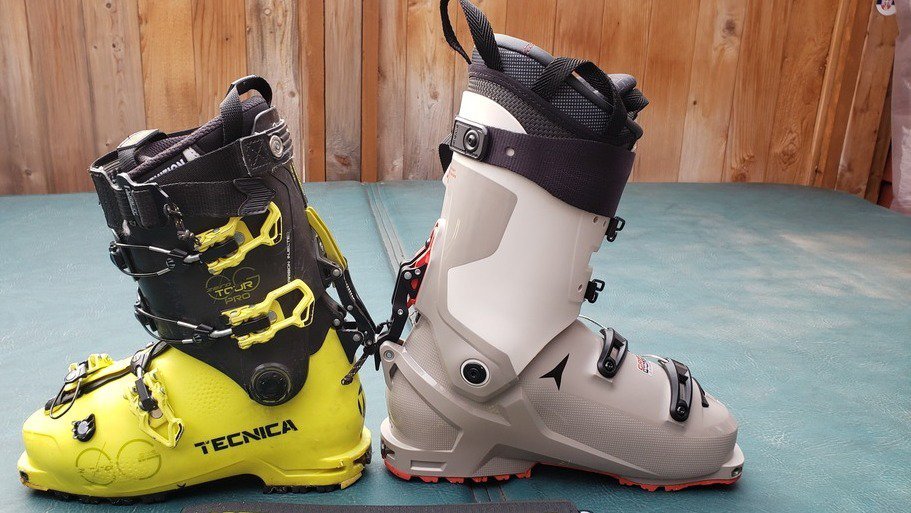
Comments